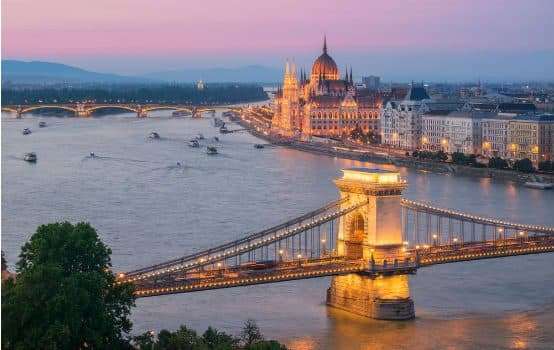
Does language reveal some deeper truth about its speakers? The Hungarians seem to think so. Their language—equal parts charmingly bizarre and unimaginably frustrating—is a lonely outlier among the Indo-European tongues of Central and Eastern Europe. That means it has plenty to say about its speakers’ heritage. Its idiosyncratic grammar, so different from any Slavic, Germanic, or Romance counterpart, is a legacy of a long medieval migration from Central Asia. Loan words from Latin, Turkish, and German are a result of successive encounters, usually tragic, with foreign powers. Even the most banal formulations have deeper significance. A Hungarian colleague once remarked that you can’t give directions without referencing the preeminent status of the country’s capital, Budapest. “It doesn’t matter where you travel,” he said. “You say you’re going up to Budapest, and down to the country.”
The urban-rural divide is a prominent feature of American politics, and it’s sometimes tempting to project our own psychoses onto a foreign landscape. But the United States’ experience is actually quite exceptional. Here, rural and conservative opprobrium isn’t directed towards one dominant metropole, but a series of affluent urban enclaves, tech corridors, wealthy suburbs, and mid-sized college towns. In Hungary, the underlying tensions are similar but the geography of resentment changes. Here, the urban-rural divide comes down to one persistent but unstable fault line: there is Budapest, and then there is the rest.
This situation is not entirely unique to Hungary. The Brexit referendum can be partly explained by London’s status as the unchallenged financial, political, and cultural center of the United Kingdom, along with all the resentment and ill feeling that position inspires. The French presidential elections revealed a similar divide: supporters of Marine Le Pen were heavily concentrated in rural areas and decaying industrial towns but nearly nonexistent in thriving, cosmopolitan Paris. In Poland, the populist conservative government had to bus in supporters from the countryside to greet Donald Trump during a recent visit to Warsaw.
America’s cultural and geographic divisions keep op-ed pages busy and have produced at least one memoir that everyone in your aunt’s monthly book club claims to have read. In Hungary, this divide is best explored through fiction. Magda Szabó, one of the great Hungarian authors of the 20th century, has only recently been introduced to English-speaking audiences through a series of excellent translations. Her books are best known for their sensitive portrayals of female relationships, but they also highlight the persistent divisions within Hungarian culture.
The Door, Szabó’s 1987 novel, is her best known work. It explores the lives of two women, Magda and Emerence, and their fraught but codependent relationship. Although the novel is set in Budapest, the two characters embody the opposing poles of Hungarian society. Magda, the younger woman, is educated and ambitious, an aspiring public intellectual who is completely at ease in the capital. Her housekeeper-cum-surrogate mother, Emerence, is the product of an altogether different Hungary: rural, agrarian, suspicious of change and abstract ideas. She is a living, breathing avatar of life outside Budapest, a constant reminder to other characters “of their old village, their own grandmothers, their distant families.” And despite her affection for Magda, Emerence is openly contemptuous of the younger woman’s career and intellectual pretensions.
Emerence may live and work in Budapest, but she has successfully adapted the customs and mores of a small village to the capital. She has a clique of confederates with whom she cleans, gossips, and generally dominates. In officious, bureaucratic Budapest, her prerogatives are preserved by a personal relationship with a police colonel. And her apartment and belongings are absolutely sacrosanct, protected by the titular door, a peasant fixation that stands out in such a cramped and intrusive city.
Emerence may embody the sensibilities of the Hungarian countryside, but by the time she’s met Magda, she has already bent Budapest to her will. Iza’s Ballad, another Szabo novel from 1963, explores a less willful outsider’s encounter with the city. When her father dies, Iza brings her mother, Ettie, to live with her in Budapest. Their relationship tragically deteriorates under the strain of proximity and Ettie’s fundamental unease over her new circumstances. She’s baffled by technology, disoriented by the pace of life in Budapest, and made to feel useless and adrift without the routines and duties of her old life.
Iza’s Ballad is a book about a generational divide, but it also reflects a geographic cleavage within Hungarian society. The traits that drive Iza apart from her mother—her commanding presence, her education, her professional ambitions—are what brought her to Budapest in the first place.
The geographic divide embodied by this relationship is particularly acute because Budapest, unlike most European capitals, is a relative upstart. The city did not emerge as a major center of Hungarian culture, politics, and industry until the late 19th century. Iza’s outlook, her entire mode of living, is Budapest in miniature: a fast-paced, forward-moving entity whose recent emergence seems disorienting—even unnatural—to many outsiders.
The fraught relationship between the capital and the hinterland dates back to the late 19th-century spasm of growth that elevated Budapest to the first rank of European capitals. The divide became a chasm in 1919, when a nationalist-conservative coalition under Admiral Horthy evicted a short-lived communist regime that seized power amidst the city’s post-war upheaval. Upon entering Budapest, Horthy declared that the capital was “bűnös,” a singularly Hungarian word that means both guilty and sinful. Coming from a member of the rural gentry, Horthy’s choice of words was a telling indicator of his political sympathies.
You can draw a straight line from the ideological combatants of the Horthy era to their modern counterparts. While liberal, cosmopolitan Budapest marches for “bridges, not walls,” Viktor Orbán, Hungary’s populist prime minister, has become one of Europe’s leading voices against the EU’s immigration policies. According to one Hungarian journalist, Orbán’s politics are a product of his own traumatic encounter with the capital. As a young man, Orbán was supposedly repelled by the hauteur and pretensions of the city’s intellectual class. This account of his political evolution may be a bit reductive, but Ettie would surely sympathize.
Contemporary Hungarian political debates are thankfully less acrimonious than the ideological clashes of the interwar period, but their significance hasn’t receded. And despite its size, Hungary’s political divisions have always resonated far outside its own borders. Depending on your sympathies, Orbán and his right-populist government are either a canary in the coal mine, a warning of how a liberal state can gradually slide into autocracy, or a necessary corrective to the excesses of the post-Cold War international order. One excitable American writer has even described Orbán’s rise as a possible blueprint for an authoritarian Trump takeover.
But if Hungary is a bellwether for the widening gyre between town and country, elites and populists, internationalists and nationalists, the relationship between Budapest and the rest of the country is also a hopeful reminder of the fruits of peaceful coexistence. Since the late 19th century, Hungarian culture has thrived on the symbiosis of rural traditions and the capital city’s dynamic character. Gyula Krúdy, another great 20th-century Hungarian author, is best known for his evocative descriptions of rural life, yet even he could not deny the capital city’s preeminence: “No matter how we country people may have been irritated, it was in Budapest that Hungarian culture, about which so many of the old, blessed Magyar people had dreamed, received its hallmark.”
And if Budapest was “the guilty city” in 1919, it must also be credited for its leading role in the great drama of modern Hungarian history, the doomed but heroic 1956 rising against the Soviets. That revolt—and the city that inspired it—is commemorated in towns and hamlets across the Hungarian plain.
Were she still alive, Szabó would surely have something to say about the troubled relationship between town and country. Her own novels exist in the tragic space where resentment and affection uneasily coexist. Both The Door and Iza’s Ballad are portraits of female relationships that deteriorate under the stress of personal ambition, divergent worldviews, and generational misunderstandings, but one of the defining features of both books is the real affection these women share at the outset. The collapse of each relationship is tragic precisely because so much love and goodwill must first be exhausted.
Szabó never indulges in lazy allegory, and it would be a mistake to extrapolate too much from either book about Hungary’s political trajectory. But her own life is a hopeful indicator for the prospects of peaceful coexistence between Budapest and the Hungarian countryside. Like so many Hungarian artists, writers, and intellectuals, Szabó was born outside Budapest but inevitably drawn to the city. Her career, and the careers of so many like her, is a product of both Hungarys. Does this bode well for political divides within other European countries, or even the United States? The Hungarians, at least, share over a thousand years of history, culture, and language that insistently bind them together. We Americans have, well, not that. Imagining Budapest without Hungary is almost beyond comprehension. Imagining our own urban enclaves separated from the rest of the country is sometimes all too plausible.
Will Collins is an English teacher who lives and works in Eger, Hungary.
Sourse: theamericanconservative.com






